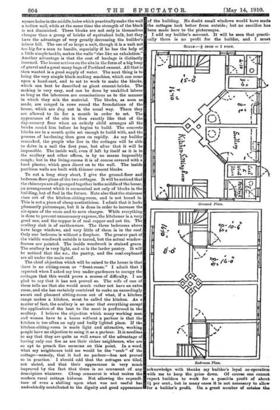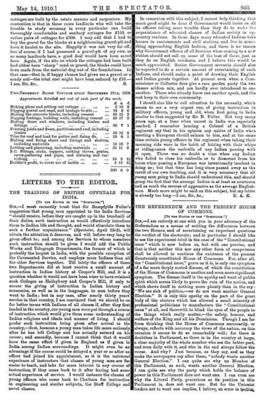CORRESPONDENCE.
THE 2150 COTTAGE. (WITH PLANS.) go TIM EDITOR 01 THE "Bezverros.-] Sfg,—The question of the cheaper housing of the people in rural districts—the problem of the cheap cottage—is still with us. Indeed, it may be said that it is destined to become more acute. There are signs that we shall obtain, owing to various agencies, a considerable increase of small holdings. But new small holdings require houses and buildings for the small holders. Meantime the spread of industries, great and small, into the country is increasing the demand for cottages. May I give your readers an account of how I was able to build a pair of cottages for £300—that is, for £150 each—in spite of the fact that the site on which I built was close on six hundred feet above the sea, and therefore the cost of haulage was very great?
The first thing to settle upon was a form of construction which would be cheap, and at the same time durable, since the situation made the houses very much exposed to the weather. Luckily for me, a local builder of intelligence had visited the first Cheap Cottages Exhibition, held at Letchworth in 1905. What he saw there induced him to adopt the system of building with concrete blocks, and he designed for himself a cheap but very practical machine which turns out excellent blocks (composed of Portland cement and gravel) eighteen inches long, nine inches high, and nine inches thick, with two square holes in the middle, boles which practicallymake the wall a hollow wall, while at the same time the strength of the block is not diminished. These blocks are not only in themselves cheaper than a group of bricks of equivalent bulk, but they have the advantage of very greatly decreasing the builder's labour bill. The use of so large a unit, though it is a unit not too big for a man to handle, especially if he has the help of a little simple tackle, makes the walls "rise like an exhalation." Another advantage is that the cost of haulage is distinctly lessened. The house arrives on the site in the form of a big heap of gravel and a great many bags of Portland cement. All that is then wanted is a good supply of water. The next thing is to bring the very simple block-making machine, which can come upon a band-cart, and to set to work to make the blocks, which can best be described as giant cement-bricks. The making is very easy, and can be done by unskilled labour as long as the labourers are conscientious as to the manner in which they mix the material. The blocks, as soon as made, are ranged in rows round the foundations of the house, which are dug out in the usual way. There they are allowed to lie for a month in order to set. The appearance of the site is then exactly like that of the day-nursery floor when an orderly child arranges all the bricks round him before he begins to build. The concrete blocks are in a month quite set enough to build with, and the process of hardening then goes on rapidly. As my builder remarked, the people who live in the cottages will be able to drive in a nail the first year, but after that it will be impossible. The inside wall, even if left by itself as it is in the scullery and other offices, is by no means impossibly rough ; but in the living-rooms it is of course covered with a bard plaster, which goes direct on to the wall. The inside partition walls are built with thinner cement blocks.
To cut a long story short, I give the ground-floor and bedroom-floor plans of the two cottages. It will be noticed that t he chimneys are all grouped together in the middle of the house, an arrangement which is economical not only of blocks in the building, but of fuel in the future. Note also that the staircase rises out of the kitchen-sitting-room, and is not boxed in. This is not a piece of cheap aestheticism. I admit that it looks pleasantly picturesque, but it is done in order to increase the air-space of the room and to save charges. While everything is done to prevent unnecessary expense, the kitchener is a very good one, and the copper is of real copper and not tin. The scullery sink is of earthenware. The three bedrooms above have large windows, and very little of them is in the roof. Only one bedroom is without a fireplace. The greater part of the visible woodwork outside is tarred, but the actual window- frames are painted. The inside woodwork is stained green. The scullery is very light, and so is the larder pantry. It will be noticed that the e.c., the pantry, and the coal-cupboard are all under the main roof.
The chief objection which will be raised to the house is that Ulere is no sitting-room or "front-room." I admit that I expected when I asked my two under-gardeners to occupy the cottages that this would prove a source of difficulty. I am glad to say that it has not proved so. The wife of one of them tells me that she would much rather not have an extra room, and she has certainly contrived to make an exceedingly smart and pleasant sitting-room out of what, if a kitchen range makes a kitchen, must be called the kitchen. As a matter of fact, the scullery is so near that everything except tile application of the heat to the meat is performed in the scullery. I believe the objection which many working men and women have to a house without a parlour is that the kitchen is too often an ugly and badly lighted place. If the kitchen-sitting-room is made light and attractive, working people have no objection to using it as a parlour. It is needless to say that they are quite as well aware of the advantage of having only one fire as are their richer neighbours, who are so apt to preach fine sermons on this point. In a word, what my neighbours told me would be the " crab " of the cottage—namely, that it had no parlour—has not proved so in practice. I should add that the cottages are tiled. not slated, and that their appearance is very much improved by the fact that there is no ornament of any description whatever. Cheap ornament is what makes the modern rural cottage hideous. Not allowing the expendi- ture of even a shilling upon what was not useful has undoubtedly contributed to the dignity and good appearance of the building. No doubt small windows would have made the cottages look better from outside ; but no sacrifice has been made here to the picturesque.
I add my builder's account. It will be seen that practi- cally there is no profit for the builder, and I must
SCALE :-6 INCH = 1 FOOT.
acknowledge with thanks my builder's loyal co-operation with me to keep the price down. Of course one cannot expect builders to work for a possible profit of about
per cent., but in many cases it is not necessary to allow for a builder's profit, On a great nuruber of estates the
Bedroom Plan, cottages are built by the estate masons and carpenters. My contention is that in these cases landlords who will take the trouble to study economy in every particular can build thoroughly comfortable and sanitary cottages for £150, or rather pairs of cottages for £300. I may add that I had to buy the gravel for the blocks at a. neighbouring gravel-pit and have it hauled to the site. Happily it was not very far off; but of course if I had possessed a gravel-pit of my own, as so many landlords have, a good deal would have been saved here. Again, if the site on which the cottages had been built had either been "sharp" sand or gravel, the blocks could have been made from the material dug out of the foundations. In that case—that is, if happy chance had given me a gravel or a sandy soil—the total cost might have been reduced by £16.-
TWO-TENEMENT BLOCK COTTAGE BUILT SEPTEMBER. 18TH, 1909. Approximate detailed net cost of each part of the work.
A s. d.
Making plans and setting out cottage ... 2 10 8 Digging gravel and sand, and haulage to site ... 16 2
Making the concrete blocks, including cement 65 15 2
Digging footings, building walls, including cement ...
39 17 3 Making doors and windows, including timber and fittings 35 '7 1 Framing joists and floors, partitions and roof, including timber 52 15 5 Tiles for roof and lead for gutter and fixing do. ... 23 6 1 Making and fixing stairs and linings and shelves, including materials ... ... 13 19 7 Lathing and plastering, including materials ... ... 31 11 9 E.C. fittings, sinks, coppers, cooking stoves, grates, eaves-guttering and pipes, and staining and var- fishing 13 2 Si Builder's profit, to cover use of tackle ... ••• 5 12 6i
300 0 0








































 Previous page
Previous page